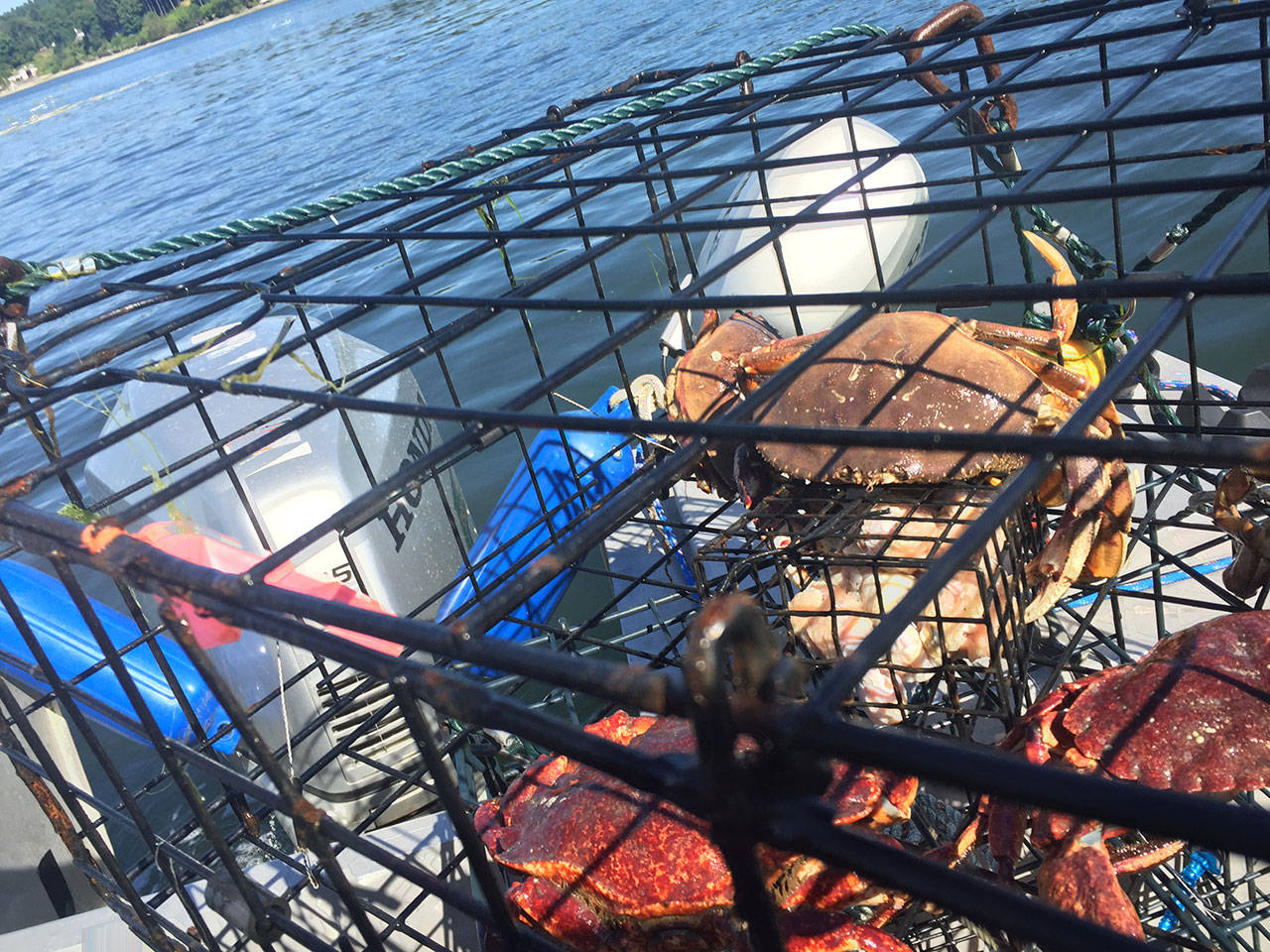The winter crabbing season is set to close at the end of the month, but several marine areas did not even open for crabbing in the fall — after countless crabbers came up empty-handed repeatedly last summer.
In fact, of the state’s 13 marine areas, five of them — all in the south sound — remained closed to crabbing when the winter season opened on Oct. 7. Don Velasquez, a fish and wildlife biologist at the Washington Department of Fish and Wildlife (WDFW), stressed this is not the norm.
“Often we have one or two areas that do not have a winter season, but it is unusual to have this number not open,” he said.
Numerous islanders were upset when few Dungeness crabs found their way into pots last summer, and now that the state has finished compiling statistics, it is clear just how poor the season was — and how few crabs appear to be living in nearby waters.
In compliance with the Rafeedie decision, which determined that tribes have the right to harvest half of all shellfish from the “usual and accustomed” places, there are both tribal and recreational crabbing seasons. Tribal catch numbers from last summer are preliminary, Velasquez cautioned, but current figures show that from Marine Area 11, which includes Vashon, tribal members harvested less than 8,700 pounds of Dungeness crab — just 8 percent of their nearly 107,000-pound harvest in 2014. The catch was also a substantial reduction from 2016, when tribal members harvested only about 30,000 pounds in the area. Like many other crabbers, tribal members quit early last summer.
“It did not make good business sense to continue,” Velasquez said.
Similarly, Marine Area 11’s recreational harvest totaled just over 17,000 pounds last summer, only 15 percent of the 2014 recreational total of 113,000 pounds and down from the previous t low of about 26,000 caught last year.
Velasquez said his agency is taking the declining numbers seriously.
“If we see this kind of low abundance again, how do we react to it?” he said. “Do we start at the same time? Do we even fish?”
Given the recent diminishing numbers and frequently empty crab pots, many crabbers want to know what is causing the trend. Some have questioned if the tribes are overfishing, but Velasquez last summer and again last week said he believes the answer is more complicated and likely includes biological and environmental causes.
He noted that Marine Areas 10 (Seattle/Bremerton) and 13 (South Puget Sound) all show the same downward trend seen near Vashon. In area 10, for example, tribal members harvested about 245,000 pounds of Dungeness crab in 2014 and 252,000 in 2015, but like near Vashon, the harvest fell dramatically last summer — to less than 68,000 pounds.
In northern marine areas, however, the harvest was good. For example, the harvest from Marine Area 8-1 near Deception Pass totaled nearly 380,000 pounds.
Currently, there are not answers to what is causing the decline in the south sound, but there are plenty of questions. Velasquez said he and tribal are considering warming waters as a possible factor. In fact, research has shown that when water is warmer than 18 degrees Celsius (64 degrees Fahrenheit), young Dungeness crab have a higher mortality rate than in cooler water. It takes four years for crabs to mature to legal size, so when considering the recent reduced harvests, it is important to look back four years to see what factors might have been at work then. What the data shows is warm water — or at least warmer than normal for Puget Sound — including areas that were warmer than 18 degrees Celsius.
“We have had more than our share of that,” said oceanographer Skip Albertson at the Washington Department of Ecology, which monitors water temperature at several places throughout the sound.
Water temperatures were typical in 2013, he said, but in 2014, they warmed considerably. Islanders may remember talk of “The Blob,” which Albertson referenced.
“Warm water came up onto the continental shelf and into Puget Sound with the arrival of the southwest wind in fall. Water temperatures went up, and stayed up from that point for several years,” he said.
Water temperature readings at Gordon Point in South Puget Sound show that in June of 2014, water temperatures were normal. By October of that year, water there was three-fourths of a degree Celsius warmer than normal. By June of 2015, that increased to 1.5 degrees Celsius and by October it was 2 degrees warmer than typical.
Temperatures at that spot were all under 15 degrees Celsius, but Albertson noted that Gordon Point is one of the cooler measuring locations in the area. Additional data showed that in July and August of 2015, in Hood Canal and other areas of South Puget Sound the water temperature was considered “especially warm” at more than 19 degrees Celsius (66 degrees Fahrenheit) and stayed warm — more than 15 degrees Celsius — for five months.
If water temperature is, in fact, affecting the Dungeness crab population, that is not good news for the crabs, the marine ecosystem or crabbers who hope to catch close to their limit—or even enough for dinner. While scientists study the issues and determine the answers, crabbing season will come again. Next summer’s season has not been set yet, Velasquez said, and will be decided on in conjunction with tribal officials closer to June – and with taking recent history into account.
“It will be a tough planning process this year,” he said.



